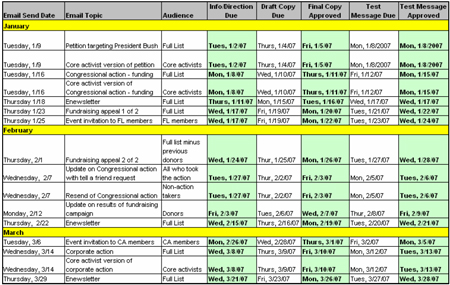Stay in Touch!
Your organization’s relationship with its email list members is not all that different from a normal offline relationship in many respects. One key requirement of maintaining a good relationship with someone in the real world is staying in touch. We all know that absence makes the heart grow fonder only in romance novels! Real people need to hear from you consistently in order to stay connected and remain interested in what you have to say.
That’s why it is crucial to commit to sending at least one list-wide email advocacy message (or its equivalent) per month. Many organizations develop a comprehensive shared messaging calendar to ensure that they are communicating regularly with their email list members. Without such a calendar (and the cross-departmental team to manage it), it is all too easy to let a month or two pass without sending an email alert to the list. You’ll find a generic example of a comprehensive email communications schedule on page three of this document.
Study Methodology
We looked at the organizations’ messaging history from November 2005 through October 2006, charting the number of messages sent to most of their list and the number of messages sent to smaller list segments. We counted the number of messages per month that were sent to over 75% of each organization’s list as well as the number of messages per month that were sent to less than 75% of their list.
We focused primarily on the number of email advocacy messages (a.k.a. action alerts) sent because these messages generate click-through and response rates that are consistent over time and across organizations, unlike some other types of messages. We define email advocacy messages as messages that ask users to fill out an online form such as an online petition or letter to a member of Congress. In addition, we recorded a count of all messages sent, whether they were fundraising, informational updates, or advocacy asks of a different kind (untrackable messages such event invites, phone calling) per month.
Unfortunately, the many variables – including varied geographical and interest area segmentation for fundraising appeals, advocacy alerts, offline event notices, and e-newsletters – made it impossible to illustrate the data in aggregate. Below is a sample of the data collected for each of the organizations. Please note that the table below does not contain real data from the study – this is sample data only.
Appendix A: Sample Email Communications Calendar
A comprehensive cross-departmental email communications schedule enables you to keep track of who on your email list is receiving what and when. Creating and maintaining a schedule of this sort takes work but is essential to ensuring that your supporters are hearing from you regularly enough to stay engaged. A cross-departmental calendar will also allow you to avoid bombarding your list members with too many email communications too close together and prevent you from sending an inappropriate flow of messages (for example, sending 10 fundraising appeals in a row with nothing else in between.) Planning out your email communications several months to a year in advance will also help ensure that you send out regular enewsletters and fundraising appeals. A good schedule also enables you to build in adequate time to gather content, review, adjust, approve, set up and test it prior to sending the messages out.


